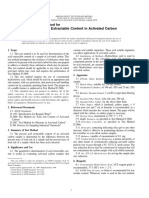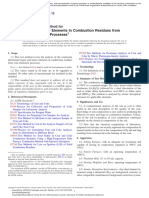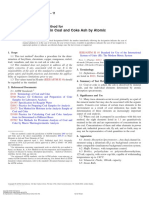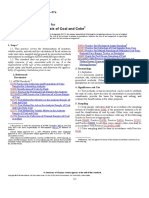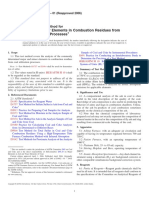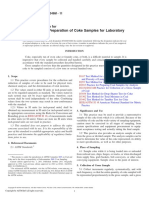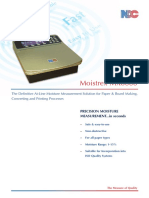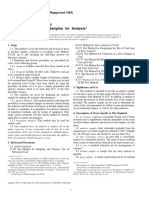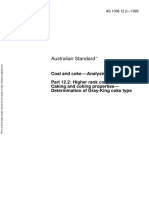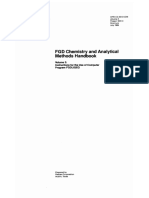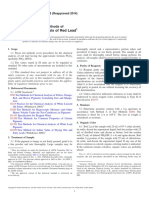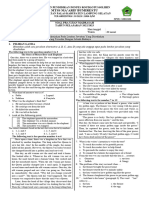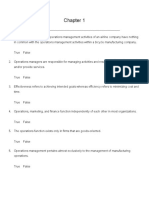1
&RS\ULJKW E\ $670 ,QW O
DOO ULJKWV UHVHUYHG
)UL -XO
*07 'RZQORDGHG SULQWHG E\
+LJKHU (GXFDWLRQ &RPPLVVLRQ SXUVXDQW WR /LFHQVH $JUHHPHQW
1R IXUWKHU UHSURGXFWLRQV DXWKRUL]HG
This international standard was developed in accordance with internationally recognized principles on standardization established in the Decision on Principles for the Development of International Standards, Guides and Recommendations issued by the World Trade Organization Technical Barriers to Trade (TBT) Committee.
Designation: D7582
−
15
Standard Test Methods for
Proximate Analysis of Coal and Coke by Macro Thermogravimetric Analysis
1
This standard is issued under the fixed designation D7582; the number immediately following the designation indicates the year of original adoption or, in the case of revision, the year of last revision. A number in parentheses indicates the year of last reapproval. Asuperscript epsilon (
s
) indicates an editorial change since the last revision or reapproval.
1.Scope
1.1These instrumental test methods cover thedetermination of moisture, volatile matter, and ash, and thecalculation of fixed carbon in the analysis of coal and cokesamples prepared in accordance with Practice D2013 andPractice D346.1.2These instrumental test methods are not applicable tothermogravimetric analyzers using microgram size samples.1.3Test Methods D3173, D3174, and D3175 shall be
considered the referee test methods.1.4The values stated in SI units are to be regarded asstandard. No other units of measurement are included in thisstandard.
1.5This standard does not purport to address all of the safety concerns, if any, associated with its use. It is theresponsibility of the user of this standard to establish appro- priate safety and health practices and determine the applica-bility of regulatory limitations prior to use.
2.Referenced Documents
2.1
ASTM Standards:
2
D121 Terminology of Coal and CokeD346 Practice for Collection and Preparation of Coke Samples for Laboratory AnalysisD2013 Practice for Preparing Coal Samples for Analysis D3173 Test Method for Moisture in the Analysis Sample of Coal and CokeD3174 Test Method for Ash in the Analysis Sample of Coaland Coke from CoalD3175 Test Method for Volatile Matter in the Analysis Sample of Coal and CokeD3176 Practice for Ultimate Analysis of Coal and Coke
1
This test method is under the jurisdiction of ASTM Committee D05 on Coaland Coke and is the direct responsibility of Subcommittee D05.21 on Methods of Analysis.Current edition approved May 15, 2015. Published June 2015. Originallyapproved in 2009. Last previous edition approved in 2012 as D7582-12. DOI:10.1520/D7582–15.
2
For referenced ASTM standards, visit the ASTM website, www.astm.org, or contact ASTM Customer Service at service@astm.org. For
Annual Book of ASTM Standards
volume information, refer to the standard’s Document Summary page onthe ASTM website.
D3180 Practice for Calculating Coal and Coke Analysesfrom As-Determined to Different BasesD3302 Test Method for Total Moisture in CoalD5016 Test Method for Total Sulfur in Coal and CokeCombustion Residues Using a High-Temperature TubeFurnace Combustion Method with Infrared AbsorptionE691 Practice for Conducting an Interlaboratory Study toDetermine the Precision of a Test Method
3.Terminology
3.1For definitions of terms used in this test method, refer to Terminology D121.
4.Summary of Test Method
4.1In thermogravimetric analysis, the mass of a sample ina controlled atmosphere is recorded repeatedly as a function of temperature or time, or both. In
macro thermogravimetric
analysis, a sample size of approximately 1 g is used. All massmeasurements are conducted by the system. In a typicalanalysis, the temperature is normally ramped from ambient toa specific temperature and held at that temperature for a prescribed length of time. The mass change is recordedrepeatedly during the entire procedure. For the thermogravi-metric analysis of coal and coke samples the moisture and ashanalyses are complete when the sample reaches a constantmass as defined in the instrumental operating parameters.Alternatively, the measurement of moisture and ash can beconsidered complete after heating the sample for a fixed period of time. In the volatile matter analysis, the samples areweighed after heating to 950°C and held at this temperaturefor 7 min.4.2
Moisture
is determined by measuring the loss in massof the analysis specimen of coal or coke when heated under specified conditions of temperature, time, atmosphere, speci-men mass, and equipment specifications.4.3
Volatile matter
is determined by measuring the loss inmass of the analysis specimen of coal or coke when heatedunder rigidly controlled conditions. The measured mass loss isused to calculate the volatile matter after correcting for themoisture content.4.4
Ash
is determined by measuring the mass of the residueremaining after burning the coal or coke specimen under

2
&RS\ULJKW E\ $670 ,QW O
DOO ULJKWV UHVHUYHG
)UL -XO
*07 'RZQORDGHG SULQWHG E\
+LJKHU (GXFDWLRQ &RPPLVVLRQ SXUVXDQW WR /LFHQVH $JUHHPHQW
1R IXUWKHU UHSURGXFWLRQV DXWKRUL]HG
Copyright © ASTM International, 100 Barr Harbor Drive, PO Box C700, West Conshohocken, PA 19428-2959. United States
&RS\ULJKW E\ $670 ,QW O
DOO ULJKWV UHVHUYHG
)UL -XO
*07 'RZQORDGHG SULQWHG E\
specified conditions of specimen mass, temperature, time,atmosphere, and equipment specifications.4.5In these test methods, moisture, volatile matter, andash can be determined sequentially in a single instrumental proce- dure. Another procedure allows the moisture and ash to be determined sequentially. Moisture and ash can also bedeter- mined in separate determinations. Ruggedness testingand past experiences have shown the volatile matter valuesdetermined on samples without first determining the moisture(drying the sample) are always higher than those of the driedsamples.
3
4.6Good laboratory practice requires checking for biases between analytical methods for contractual compliance. Whenonly a few coal types will be routinely tested, the instrumentused in these test methods must be shown to yield results, for the coal(s) to be tested, that are equivalent to those obtainedusing Test Methods D3173, D3174, and D3175. If they are
found to be not equivalent, either the instrument used iscalibrated or the instrumental results are adjusted to establishand maintain equivalence. Alternatively, when a broad spec-trum of coal types will be tested, the instrument used in thesetest methods shall be calibrated using certified referencematerials of known composition covering the range of param-eters being determined. The certified values shall be estab-lished using Test Methods D3173, D3174, and D3175. Section
16.2 lists a number of biases that have been shown to exist between instrumental results. Other biases, of unknown mag-nitude and sign, may exist for other coals.
3
5.Significance and Use
5.1
Moisture
, as determined by this instrumental testmethod, is used for calculating other analytical results to a dry basis using procedures in Practice D3180.5.2
Moisture
can be used in conjunction with the air-drymoisture loss determined by Test Method D3302 to determinetotal moisture in coal. Total moisture is used for calculatingother analytical results to an as-received basis using PracticeD3180.5.3
Ash yield
is the residue remaining after heating the coaland coke samples (see Note 1).
N
OTE
1—The ash obtained differs in composition and amount from themineral constituents present in the original coal. Combustion causes anexpulsion of all water, the loss of carbon dioxide from carbonates, theconversion of iron pyrite into iron oxides and sulfur oxides, and other chemical reactions. Ash yield, as determined by this test method, candiffer from the amount of ash produced in furnace operations or other combustion systems because combustion conditions influence the chem-istry and amount of ash.
5.4
Ash yield
is used,
(1)
as a parameter for evaluatingsampling procedures and coal cleaning processes,
(2)
in theultimate analysis calculation of oxygen by difference usingPractice D3176,
(3)
in calculations including material balance,reactivity and yields of products relevant to coal conversion processes such as gasification and liquefaction,
(4)
in calcula-
3
Riley J.T., Yanes E.G, Marsh M., Lawrenz D., and Eichenbaum L., “Coal andCoke Volatile Matter Determination and Reconciliation of Differences in YieldsDetermined by Two ASTM Methods,”
J. Testing and Evaluation
, 2010, 38(4),458-466.
tions to estimate the loading on electrostatic precipitators andon the fly ash and bottom ash disposal systems as well aserosion rates on boiler systems.5.5
Volatile matter yield
, when determined as hereindescribed, may be used to
(1)
indicate coke yield oncarbonization,
(2)
provide the basis for purchasing and selling,or
(3)
establish combustion characteristics.5.6
Fixed carbon
is a calculated value. It is the difference between 100 and the sum of the percent moisture, ash, andvolatile matter. All percents shall be on the same moisturereference base.5.7Moisture, ash, and volatile matter are three of the principal parameters used for assessing the quality of coal.
6.Interferences
6.1There are no known interferences for these test methods.
7.Apparatus
7.1
Macro Thermogravimetric Analyzer (Macro TGA)—
Acomputer controlled apparatus consisting of a furnace with acavity large enough to accept crucibles containing test speci-mens that meet the minimum mass requirements of the procedure. The macro TGA system can accommodate multiplecrucibles, allowing for continuous analysis with one cruciblereserved for the blank or reference crucible. The furnace isconstructed so the cavity is surrounded by a suitable refractoryand insulated so as to develop a uniform temperature in all parts of the cavity, but with a minimum free space. Thefurnace shall be capable of being heated rapidly (30-45°C/minfrom ambient to 950°C. The temperature shall be monitoredand maintained at values specified for each determination. Thesystem shall have an integrated balance capable of weighingthe crucibles and test specimens repeatedly throughout theanalysis. All mass measurements are conducted and recorded by the system. The sensitivity of the balance shall be at least0.1 mg. Provision shall be made to introduce gases specifiedfor this standard and to remove products of drying,
devolatilization, and combustion. The macro TGA system shall
have a venting fan, tolerant of hot product gases, to efficientlyremove the exhaust gases.7.2
Crucibles—
with covers of composition and dimensionsspecified for the instrument by the instrument manufacturer.The covers shall fit closely enough so that the carbon depositfrom bituminous, subbituminous, and lignitic coals does not burn away from the underside of the cover during the deter-mination of the volatile matter
8.Reagents and Materials
8.1
Drying Gas—
Nitrogen (99.5% purity), Argon (99.5% purity) or air, dried to a moisture content of 1.9 mg/L or less(dew point –10°C or less).8.2
Inert Gas—
Nitrogen (99.5% purity) or Argon (99.5% purity).8.3
Oxidizing Gas—
Oxygen (99.5% purity) or air.8.4
Certified Reference Materials—
Coal or cokematerial(s) meeting the requirements of 10.1, with a certificate
&RS\ULJKW E\ $670 ,QW O
DOO ULJKWV UHVHUYHG
)UL -XO
*07 'RZQORDGHG SULQWHG E\
of analysis



